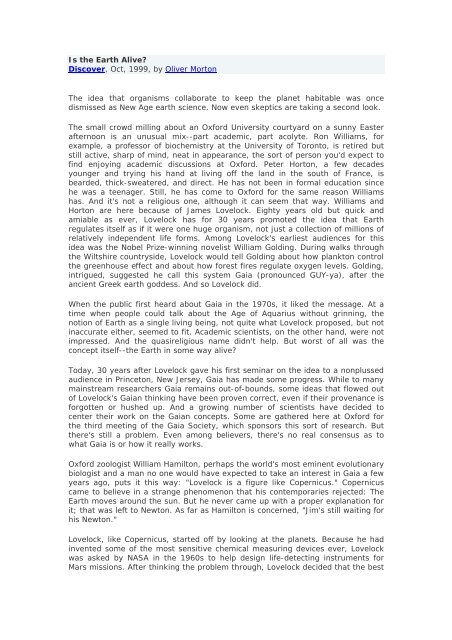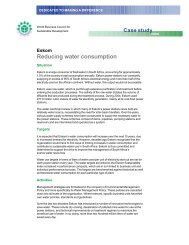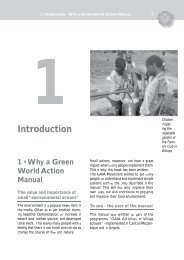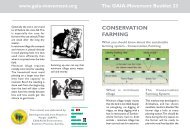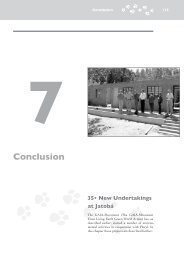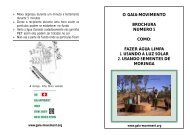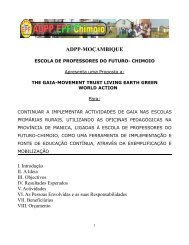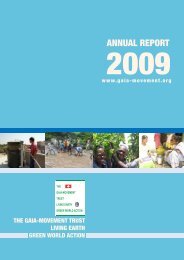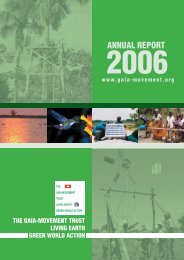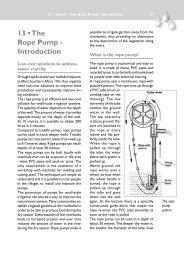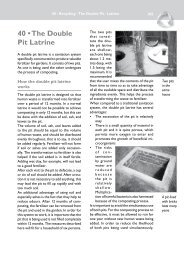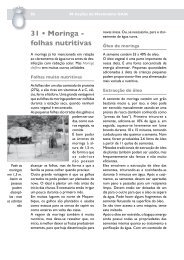Read or download the whole article at (PDF - The Gaia-Movement
Read or download the whole article at (PDF - The Gaia-Movement
Read or download the whole article at (PDF - The Gaia-Movement
Create successful ePaper yourself
Turn your PDF publications into a flip-book with our unique Google optimized e-Paper software.
Is <strong>the</strong> Earth Alive?<br />
Discover, Oct, 1999, by Oliver M<strong>or</strong>ton<br />
<strong>The</strong> idea th<strong>at</strong> <strong>or</strong>ganisms collab<strong>or</strong><strong>at</strong>e to keep <strong>the</strong> planet habitable was once<br />
dismissed as New Age earth science. Now even skeptics are taking a second look.<br />
<strong>The</strong> small crowd milling about an Oxf<strong>or</strong>d University courtyard on a sunny Easter<br />
afternoon is an unusual mix--part academic, part acolyte. Ron Williams, f<strong>or</strong><br />
example, a profess<strong>or</strong> of biochemistry <strong>at</strong> <strong>the</strong> University of T<strong>or</strong>onto, is retired but<br />
still active, sharp of mind, ne<strong>at</strong> in appearance, <strong>the</strong> s<strong>or</strong>t of person you'd expect to<br />
find enjoying academic discussions <strong>at</strong> Oxf<strong>or</strong>d. Peter H<strong>or</strong>ton, a few decades<br />
younger and trying his hand <strong>at</strong> living off <strong>the</strong> land in <strong>the</strong> south of France, is<br />
bearded, thick-swe<strong>at</strong>ered, and direct. He has not been in f<strong>or</strong>mal educ<strong>at</strong>ion since<br />
he was a teenager. Still, he has come to Oxf<strong>or</strong>d f<strong>or</strong> <strong>the</strong> same reason Williams<br />
has. And it's not a religious one, although it can seem th<strong>at</strong> way. Williams and<br />
H<strong>or</strong>ton are here because of James Lovelock. Eighty years old but quick and<br />
amiable as ever, Lovelock has f<strong>or</strong> 30 years promoted <strong>the</strong> idea th<strong>at</strong> Earth<br />
regul<strong>at</strong>es itself as if it were one huge <strong>or</strong>ganism, not just a collection of millions of<br />
rel<strong>at</strong>ively independent life f<strong>or</strong>ms. Among Lovelock's earliest audiences f<strong>or</strong> this<br />
idea was <strong>the</strong> Nobel Prize-winning novelist William Golding. During walks through<br />
<strong>the</strong> Wiltshire countryside, Lovelock would tell Golding about how plankton control<br />
<strong>the</strong> greenhouse effect and about how f<strong>or</strong>est fires regul<strong>at</strong>e oxygen levels. Golding,<br />
intrigued, suggested he call this system <strong>Gaia</strong> (pronounced GUY-ya), after <strong>the</strong><br />
ancient Greek earth goddess. And so Lovelock did.<br />
When <strong>the</strong> public first heard about <strong>Gaia</strong> in <strong>the</strong> 1970s, it liked <strong>the</strong> message. At a<br />
time when people could talk about <strong>the</strong> Age of Aquarius without grinning, <strong>the</strong><br />
notion of Earth as a single living being, not quite wh<strong>at</strong> Lovelock proposed, but not<br />
inaccur<strong>at</strong>e ei<strong>the</strong>r, seemed to fit. Academic scientists, on <strong>the</strong> o<strong>the</strong>r hand, were not<br />
impressed. And <strong>the</strong> quasireligious name didn't help. But w<strong>or</strong>st of all was <strong>the</strong><br />
concept itself--<strong>the</strong> Earth in some way alive?<br />
Today, 30 years after Lovelock gave his first seminar on <strong>the</strong> idea to a nonplussed<br />
audience in Princeton, New Jersey, <strong>Gaia</strong> has made some progress. While to many<br />
mainstream researchers <strong>Gaia</strong> remains out-of-bounds, some ideas th<strong>at</strong> flowed out<br />
of Lovelock's <strong>Gaia</strong>n thinking have been proven c<strong>or</strong>rect, even if <strong>the</strong>ir provenance is<br />
f<strong>or</strong>gotten <strong>or</strong> hushed up. And a growing number of scientists have decided to<br />
center <strong>the</strong>ir w<strong>or</strong>k on <strong>the</strong> <strong>Gaia</strong>n concepts. Some are ga<strong>the</strong>red here <strong>at</strong> Oxf<strong>or</strong>d f<strong>or</strong><br />
<strong>the</strong> third meeting of <strong>the</strong> <strong>Gaia</strong> Society, which spons<strong>or</strong>s this s<strong>or</strong>t of research. But<br />
<strong>the</strong>re's still a problem. Even among believers, <strong>the</strong>re's no real consensus as to<br />
wh<strong>at</strong> <strong>Gaia</strong> is <strong>or</strong> how it really w<strong>or</strong>ks.<br />
Oxf<strong>or</strong>d zoologist William Hamilton, perhaps <strong>the</strong> w<strong>or</strong>ld's most eminent evolutionary<br />
biologist and a man no one would have expected to take an interest in <strong>Gaia</strong> a few<br />
years ago, puts it this way: "Lovelock is a figure like Copernicus." Copernicus<br />
came to believe in a strange phenomenon th<strong>at</strong> his contemp<strong>or</strong>aries rejected: <strong>The</strong><br />
Earth moves around <strong>the</strong> sun. But he never came up with a proper explan<strong>at</strong>ion f<strong>or</strong><br />
it; th<strong>at</strong> was left to Newton. As far as Hamilton is concerned, "Jim's still waiting f<strong>or</strong><br />
his Newton."<br />
Lovelock, like Copernicus, started off by looking <strong>at</strong> <strong>the</strong> planets. Because he had<br />
invented some of <strong>the</strong> most sensitive chemical measuring devices ever, Lovelock<br />
was asked by NASA in <strong>the</strong> 1960s to help design life-detecting instruments f<strong>or</strong><br />
Mars missions. After thinking <strong>the</strong> problem through, Lovelock decided th<strong>at</strong> <strong>the</strong> best
way to detect life on ano<strong>the</strong>r planet was to look <strong>at</strong> <strong>the</strong> <strong>at</strong>mosphere. If a planet<br />
had life like Earth's, its <strong>at</strong>mospheric composition would reflect it.<br />
<strong>The</strong> proof, he argued, is in every bre<strong>at</strong>h you take. Earth, abundant with life, has<br />
an <strong>at</strong>mosphere composed of an unstable mixture of gases. If you bottled a<br />
sample of Earth's <strong>at</strong>mosphere f<strong>or</strong> a million years, <strong>the</strong> mingled gases would react<br />
with one ano<strong>the</strong>r. But strangely, if <strong>the</strong> mixture is left outside <strong>the</strong> bottle, it stays<br />
reasonably stable because life f<strong>or</strong>ms abs<strong>or</strong>b some of <strong>the</strong> gases and replenish<br />
o<strong>the</strong>rs.<br />
Lovelock surmised th<strong>at</strong> if Mars had life, its <strong>at</strong>mosphere would show similar<br />
characteristics. <strong>The</strong> fact th<strong>at</strong> it didn't, he concluded, meant th<strong>at</strong> Mars was dead --<br />
and <strong>the</strong>ref<strong>or</strong>e not w<strong>or</strong>th <strong>the</strong> cost of sending spacecraft to look f<strong>or</strong> life. This was<br />
not <strong>the</strong> answer NASA wanted, although all subsequent studies have tended to<br />
supp<strong>or</strong>t it.<br />
Lovelock went on to look <strong>at</strong> o<strong>the</strong>r ways in which life might shape <strong>the</strong> development<br />
of Earth. F<strong>or</strong> example, we know th<strong>at</strong> when <strong>the</strong> solar system was f<strong>or</strong>med <strong>the</strong> sun<br />
was dim and th<strong>at</strong> it has he<strong>at</strong>ed up ever since. Yet Earth wasn't too cold f<strong>or</strong> life in<br />
<strong>the</strong> beginning, and it isn't too hot f<strong>or</strong> life now. Th<strong>at</strong>'s because <strong>the</strong> composition of<br />
<strong>the</strong> <strong>at</strong>mosphere has changed. Huge amounts of warming carbon dioxide have<br />
conveniently been abs<strong>or</strong>bed by little planktonic shellfish and used to make shells.<br />
When <strong>the</strong> animals die, <strong>the</strong> carbon dioxide is locked up as <strong>the</strong>ir remains turn into<br />
chalk <strong>or</strong> limestone.<br />
<strong>The</strong>n <strong>the</strong>re is sulfur, which has to be recycled from <strong>the</strong> sea to <strong>the</strong> land f<strong>or</strong> life to<br />
go on. Lovelock suggested th<strong>at</strong> this recycling was done by living cre<strong>at</strong>ures ra<strong>the</strong>r<br />
than by in<strong>or</strong>ganic processes. He was proven right. Plankton pump m<strong>or</strong>e sulfur<br />
into <strong>the</strong> <strong>at</strong>mosphere than all <strong>the</strong> w<strong>or</strong>ld's volcanoes. Lovelock started to think th<strong>at</strong><br />
Earth was in some sense alive, its various cycles part of a gre<strong>at</strong> physiology.<br />
Of all those who objected to <strong>the</strong> idea, no group was m<strong>or</strong>e vehement than<br />
evolutionary biologists. <strong>The</strong>y don't believe in free lunches. <strong>The</strong>y believe cre<strong>at</strong>ures<br />
are out to help <strong>the</strong>mselves and <strong>the</strong>ir rel<strong>at</strong>ives survive, not to help strangers. <strong>The</strong><br />
idea th<strong>at</strong> some cre<strong>at</strong>ures waste eff<strong>or</strong>t making <strong>the</strong> w<strong>or</strong>ld a better place f<strong>or</strong> o<strong>the</strong>rs<br />
didn't make sense to <strong>the</strong>m. As f<strong>or</strong> global self-regul<strong>at</strong>ion, <strong>the</strong> complex<br />
physiological systems of living beings do not come about by chance. <strong>The</strong>y evolve.<br />
Many different versions are tried out; only <strong>the</strong> best leave descendants. Th<strong>at</strong>'s<br />
n<strong>at</strong>ural selection. And n<strong>at</strong>ural selection cannot apply to a <strong>whole</strong> planet, which has<br />
no competit<strong>or</strong>s <strong>or</strong> ancest<strong>or</strong>s.<br />
To convince <strong>the</strong> evolutionary biologists, Lovelock needed a way of demonstr<strong>at</strong>ing<br />
how <strong>or</strong>ganisms could act selfishly yet still interact to control <strong>the</strong> planet. His<br />
solution was to invent a computer model called Daisyw<strong>or</strong>ld. Imagine, he said, a<br />
cold planet with a dim young sun. On this planet are two kinds of daisies, black<br />
and white. <strong>The</strong> black daisies begin to spread across <strong>the</strong> face of <strong>the</strong> w<strong>or</strong>ld, soaking<br />
up sunlight and warming <strong>the</strong>mselves. In doing so, <strong>the</strong>y take <strong>the</strong> chill from <strong>the</strong><br />
ground and warm <strong>the</strong> air. But as <strong>the</strong> sun slowly grows warmer, Daisyw<strong>or</strong>ld's<br />
temper<strong>at</strong>ure remains stable because <strong>the</strong> white daisies begin spreading around <strong>the</strong><br />
w<strong>or</strong>ld, reflecting <strong>the</strong> sun's rays back into space. <strong>The</strong>y cool <strong>the</strong>mselves, <strong>the</strong> ground<br />
bene<strong>at</strong>h <strong>the</strong>m, and <strong>the</strong> air above. <strong>The</strong> black daisies, on <strong>the</strong> o<strong>the</strong>r hand, bake to a<br />
crisp and die out. So <strong>the</strong> planet's surface grows ever whiter, and its overall<br />
temper<strong>at</strong>ure stays <strong>the</strong> same.<br />
<strong>The</strong> charm of this parable is th<strong>at</strong> <strong>the</strong> daisies didn't set out to keep <strong>the</strong> planet's<br />
temper<strong>at</strong>ure stable, but still <strong>the</strong>y did so. <strong>The</strong> rig<strong>or</strong>s of <strong>the</strong> environment controlled
<strong>the</strong> daisies' f<strong>at</strong>e, and <strong>the</strong> temper<strong>at</strong>ure regul<strong>at</strong>ion came free. Evolutionary<br />
biologists still didn't buy it. William Hamilton, who has done m<strong>or</strong>e than anyone<br />
else to understand how genes can, in some circumstances, make <strong>the</strong> cre<strong>at</strong>ures<br />
th<strong>at</strong> bear <strong>the</strong>m nice to one ano<strong>the</strong>r, saw Daisyw<strong>or</strong>ld as rigged. He pointed out<br />
th<strong>at</strong> if <strong>the</strong> daisies had been allowed to evolve, ra<strong>the</strong>r than f<strong>or</strong>ced to sit with <strong>the</strong><br />
same temper<strong>at</strong>ure preferences <strong>the</strong>y started out with, <strong>the</strong>y would adapt<br />
<strong>the</strong>mselves to <strong>the</strong> sun's ever-increasing he<strong>at</strong> and allow <strong>the</strong> environment to go to<br />
hell. "It doesn't account f<strong>or</strong> how <strong>the</strong> phenomenon [large-scale stabilities in <strong>the</strong><br />
environment] appears," says Hamilton. "Th<strong>at</strong>'s wh<strong>at</strong> we're still waiting f<strong>or</strong>."<br />
Which brings us back to wh<strong>at</strong> <strong>Gaia</strong> is supposed to be. Is it a system, a property of<br />
a system, a process, a thing? All those views could have found supp<strong>or</strong>t <strong>at</strong> <strong>the</strong><br />
Oxf<strong>or</strong>d meeting. New Y<strong>or</strong>k University biology profess<strong>or</strong> Tyler Volk, f<strong>or</strong> example,<br />
calls <strong>Gaia</strong> a thing: a system comprising Earth's soils, oceans, <strong>at</strong>mosphere, and<br />
biomass. F<strong>or</strong> Volk, <strong>Gaia</strong>n studies show how things circul<strong>at</strong>e through this system.<br />
No need f<strong>or</strong> Daisyw<strong>or</strong>lds, no need f<strong>or</strong> anything but n<strong>at</strong>ural selection. On <strong>the</strong> o<strong>the</strong>r<br />
hand, Lee Klinger, a researcher <strong>at</strong> <strong>the</strong> N<strong>at</strong>ional Center f<strong>or</strong> Atmospheric Research<br />
in Boulder, thinks <strong>the</strong>re's m<strong>or</strong>e to <strong>Gaia</strong>. To him, it's basically similar to all s<strong>or</strong>ts of<br />
o<strong>the</strong>r complex phenomena, from <strong>at</strong>oms in magnetic fields to gamblers playing <strong>the</strong><br />
stock market.<br />
F<strong>or</strong> <strong>the</strong> hard c<strong>or</strong>e, <strong>Gaia</strong> is about biology, not earth science <strong>or</strong> complex systems.<br />
<strong>The</strong>ir b<strong>at</strong>tle cry is symbiosis, <strong>the</strong> many varied ways th<strong>at</strong> cre<strong>at</strong>ures have of coming<br />
to depend on one ano<strong>the</strong>r. Th<strong>at</strong>'s something <strong>Gaia</strong>ns think traditional evolutionary<br />
biologists don't know how to deal with. Hamilton disagrees with th<strong>at</strong>. But he<br />
agrees th<strong>at</strong> <strong>the</strong>re seem to be long-term stabilities in <strong>the</strong> environment th<strong>at</strong> he and<br />
his colleagues may have underplayed. This intrigues him deeply--and th<strong>at</strong> may<br />
help bring <strong>Gaia</strong> a new respectability.<br />
Hamilton first began investig<strong>at</strong>ing <strong>Gaia</strong>n ideas while w<strong>or</strong>king with a young<br />
protege of Lovelock's, Tim Lenton, now <strong>at</strong> Edinburgh's Institute of Terrestrial<br />
Ecology <strong>The</strong>y were thinking about <strong>the</strong> plankton th<strong>at</strong> release a kind of sulfur into<br />
<strong>the</strong> ocean, where it reacts and f<strong>or</strong>ms dimethyl sulfide. Some of this gas escapes<br />
into <strong>the</strong> <strong>at</strong>mosphere, interacts with oxygen, and f<strong>or</strong>ms little acidic p<strong>article</strong>s. <strong>The</strong><br />
p<strong>article</strong>s help f<strong>or</strong>m cloud droplets, and m<strong>or</strong>e droplets mean thicker, whiter clouds.<br />
Bob Charlson, a profess<strong>or</strong> of <strong>at</strong>mospheric sciences and chemistry <strong>at</strong> <strong>the</strong><br />
University of Washington who collab<strong>or</strong><strong>at</strong>ed with Lovelock, reckons th<strong>at</strong> if <strong>the</strong><br />
ocean did not release dimethyl sulfide, <strong>the</strong> number of droplets in <strong>the</strong> most<br />
common marine clouds would be less than half of wh<strong>at</strong> it is today So if it weren't<br />
f<strong>or</strong> sulfur-producing plankton, <strong>the</strong> planet might be much hotter. <strong>The</strong> plankton's<br />
product could conceivably be changing <strong>the</strong> n<strong>at</strong>ure of <strong>the</strong> clouds enough to cool<br />
<strong>the</strong> planet by as much as 10 degrees Celsius.<br />
<strong>Gaia</strong>ns take this as evidence th<strong>at</strong> <strong>the</strong>se plankton are part of Earth's way of<br />
staying cool. But why should <strong>the</strong> plankton bo<strong>the</strong>r? Th<strong>at</strong> was <strong>the</strong> question th<strong>at</strong><br />
struck Hamilton. As an evolutionary biologist, he tended to think <strong>or</strong>ganisms are<br />
mostly interested in improving <strong>the</strong>ir odds of reproduction. He couldn't accept th<strong>at</strong><br />
plankton cooled <strong>the</strong> w<strong>or</strong>ld with no benefit f<strong>or</strong> <strong>the</strong>mselves. So he enlisted Lenton's<br />
help in looking f<strong>or</strong> a payoff.<br />
<strong>The</strong>ir answer was strange but appealing: Plankton encourage clouds because<br />
clouds help plankton spread <strong>the</strong>ir genes around. Hamilton and his colleagues<br />
showed th<strong>at</strong> dispersing some of your seeds always makes sense, even if <strong>the</strong>ir<br />
chance of thriving wherever <strong>the</strong>y end up is tiny If this is true, <strong>the</strong>n contributing to<br />
<strong>the</strong> release of dimethyl sulfide may be one way plankton can move to new<br />
territ<strong>or</strong>y Producing dimethyl sulfide, in sh<strong>or</strong>t, could help cre<strong>at</strong>e winds th<strong>at</strong> whip
up whitecaps and loft plankton into <strong>the</strong> air. If plankton somehow get into <strong>the</strong><br />
clouds, <strong>the</strong>y could travel significant distances--hundreds <strong>or</strong> even thousands of<br />
miles--bef<strong>or</strong>e coming down.<br />
It's a nice idea, one you could expect n<strong>at</strong>ural selection to fav<strong>or</strong>. It may even be<br />
true, though no one has yet caught <strong>the</strong> astronaut algae on <strong>the</strong>ir way to <strong>the</strong><br />
clouds. But does it supp<strong>or</strong>t Lovelock's <strong>the</strong><strong>or</strong>y? <strong>The</strong> fact th<strong>at</strong> <strong>the</strong> clouds are being<br />
made by <strong>the</strong> plankton is interesting. <strong>The</strong> possibility th<strong>at</strong> <strong>the</strong>se clouds are<br />
significantly cooling <strong>the</strong> planet is imp<strong>or</strong>tant. But <strong>the</strong>se insights don't prove <strong>the</strong><br />
<strong>Gaia</strong>n <strong>the</strong><strong>or</strong>y th<strong>at</strong> life and <strong>the</strong> environment come toge<strong>the</strong>r to f<strong>or</strong>m a selfregul<strong>at</strong>ing<br />
<strong>whole</strong>.<br />
To try and get a better take on <strong>Gaia</strong> <strong>at</strong> th<strong>at</strong> most basic level, Hamilton and<br />
ecologist Peter Henderson are trying to build a m<strong>or</strong>e realistic model to replace<br />
Daisyw<strong>or</strong>ld. <strong>The</strong>y want a model th<strong>at</strong> shows a suite of <strong>or</strong>ganisms whose<br />
interactions stabilize <strong>the</strong> environment in ways th<strong>at</strong> don't depend on <strong>the</strong><br />
parameters <strong>the</strong> model starts with. <strong>The</strong>ir first stab <strong>at</strong> an answer, presented <strong>at</strong> <strong>the</strong><br />
Oxf<strong>or</strong>d conference, could be called Damw<strong>or</strong>ld.<br />
Imagine Damw<strong>or</strong>ld as a basin ringed by mountains, in which a single species of<br />
algae lives. <strong>The</strong> rain th<strong>at</strong> falls into Damw<strong>or</strong>ld can leave only through one narrow<br />
outlet. Living in <strong>the</strong> outlet are cre<strong>at</strong>ures th<strong>at</strong> feed on <strong>the</strong> algae. <strong>The</strong>se cre<strong>at</strong>ures<br />
anch<strong>or</strong> <strong>the</strong>mselves to <strong>the</strong> sediments and tend to build up a dam, like c<strong>or</strong>al polyps<br />
build up a reef. <strong>The</strong> third species is one th<strong>at</strong> breaks down dams f<strong>or</strong> food. If <strong>the</strong><br />
dam rises, <strong>the</strong> lake behind it swells, cre<strong>at</strong>ing a larger supply of sunlight-warmed,<br />
nutrient-rich w<strong>at</strong>er in which various <strong>or</strong>ganisms thrive.<br />
If you have just those three species, <strong>the</strong>n <strong>the</strong> dam's height oscill<strong>at</strong>es fairly<br />
regularly When it gets big, <strong>the</strong>re's m<strong>or</strong>e f<strong>or</strong> <strong>the</strong> dam-busters to w<strong>or</strong>k on and <strong>the</strong><br />
dam starts to crumble. When it crumbles, <strong>the</strong> dam-busters starve and <strong>the</strong><br />
builders make <strong>the</strong> dam bigger again. But Henderson and Hamilton aren't content<br />
with just three species. Each time <strong>the</strong> model runs, <strong>the</strong>y add new species to <strong>the</strong><br />
<strong>or</strong>iginal three. <strong>The</strong>se species are similar to <strong>the</strong> <strong>or</strong>iginals, but with randomly<br />
assigned food and habit<strong>at</strong> preferences th<strong>at</strong> are just different enough to make<br />
things interesting. Sometimes <strong>the</strong> newcomers cooper<strong>at</strong>e with <strong>the</strong> established<br />
species; sometimes <strong>the</strong>y compete.<br />
Each time <strong>the</strong> model runs, <strong>the</strong> result is different. But over many runs, some<br />
st<strong>at</strong>istical trends emerged. W<strong>or</strong>lds with tall dams, on average, accumul<strong>at</strong>e m<strong>or</strong>e<br />
species and richer ecosystems than those with sh<strong>or</strong>ter dams. Wh<strong>at</strong>'s m<strong>or</strong>e, <strong>the</strong>y<br />
also resist shocks better. <strong>The</strong>y're not without problems, but <strong>the</strong>y are robust. In<br />
damless w<strong>or</strong>lds, <strong>the</strong> model often ends with everything going extinct after <strong>the</strong><br />
introduction of some vicious new species. While total extinction can happen in<br />
w<strong>or</strong>lds with big dams, it is much rarer.<br />
Wh<strong>at</strong> seems to m<strong>at</strong>ter most in <strong>the</strong> model is how much control <strong>the</strong> various species<br />
gain over <strong>the</strong> physical aspects of <strong>the</strong>ir w<strong>or</strong>ld. <strong>The</strong> m<strong>or</strong>e profound <strong>the</strong> links<br />
between wh<strong>at</strong>'s alive and wh<strong>at</strong> isn't, <strong>the</strong> m<strong>or</strong>e stable things seem to get. Big<br />
changes can still occur in such systems, but <strong>the</strong>y are not necessarily irreversible.<br />
Damw<strong>or</strong>ld seems to suggest th<strong>at</strong> <strong>the</strong> m<strong>or</strong>e intim<strong>at</strong>ely life intermingles with its<br />
physical environment, <strong>the</strong> m<strong>or</strong>e <strong>the</strong> two may toge<strong>the</strong>r move toward stability. But<br />
it offers no certainty: Sometimes dammed ecosystems are unstable. Th<strong>at</strong> <strong>Gaia</strong>like<br />
properties develop in <strong>the</strong> Damw<strong>or</strong>ld model only sometimes, not always, could<br />
point toward ano<strong>the</strong>r concept of <strong>Gaia</strong>. This concept was voiced <strong>at</strong> <strong>the</strong> Oxf<strong>or</strong>d
conference by Andrew W<strong>at</strong>son, a profess<strong>or</strong> of environmental science <strong>at</strong> <strong>the</strong><br />
University of East Anglia. Maybe, he said, <strong>Gaia</strong> is an accident.<br />
W<strong>at</strong>son, one of Lovelock's first disciples and his co-auth<strong>or</strong> on <strong>the</strong> <strong>or</strong>iginal<br />
Daisyw<strong>or</strong>ld paper, argues th<strong>at</strong> with just one Earth to study, you simply can't say<br />
much about <strong>Gaia</strong>. Just because life persists on this planet despite all s<strong>or</strong>ts of<br />
change doesn't mean th<strong>at</strong> it had to. Yes, some nice, big, simple feedback loops<br />
involving <strong>at</strong>mosphere and <strong>or</strong>ganisms may have done a lot to make <strong>the</strong> planet<br />
livable, but th<strong>at</strong> doesn't mean <strong>the</strong>se interactions were a necessary outcome of life<br />
being <strong>the</strong>re in <strong>the</strong> first place. Maybe we just got lucky<br />
And th<strong>at</strong> brings us back to where Lovelock began: looking <strong>at</strong> <strong>the</strong> <strong>at</strong>mospheres of<br />
o<strong>the</strong>r planets. Although NASA didn't much like Lovelock's <strong>the</strong><strong>or</strong>y th<strong>at</strong> <strong>the</strong> Martian<br />
<strong>at</strong>mosphere proved <strong>the</strong> planet lifeless, it has adopted his <strong>the</strong><strong>or</strong>y f<strong>or</strong> finding life<br />
outside <strong>the</strong> solar system. When planets <strong>the</strong> size of Earth are found, <strong>the</strong> next<br />
<strong>or</strong>der of business will be studying <strong>the</strong>ir <strong>at</strong>mospheres through spectroscopy to see<br />
whe<strong>the</strong>r <strong>the</strong>y are de<strong>at</strong>hly stable, like those of Mars and Venus, <strong>or</strong> alive and<br />
kicking like Earth's.<br />
<strong>The</strong> extra<strong>or</strong>dinary space telescopes needed to make such measurements are in<br />
<strong>the</strong> w<strong>or</strong>ks. If <strong>the</strong> search turns up living planets, W<strong>at</strong>son's accident <strong>the</strong><strong>or</strong>y, and<br />
<strong>the</strong> general credibility of <strong>Gaia</strong>, could be tested. If <strong>the</strong> sustainability of Life on<br />
planets is a m<strong>at</strong>ter of luck, Life will be most common around young stars, where<br />
its luck hasn't yet been tested. But if Life makes its own luck, as <strong>Gaia</strong> would have<br />
us believe, <strong>the</strong>n <strong>the</strong>re will be life on planets around stars of all ages. We could<br />
know within a few decades.<br />
And wh<strong>at</strong> does Lovelock make of this? He's happy th<strong>at</strong> <strong>Gaia</strong> is still alive, still<br />
<strong>at</strong>tracting interesting people, still provoking new lines of thought. If not all of it<br />
acc<strong>or</strong>ds with his own ideas, well, fine.<br />
Lovelock didn't present any new hypo<strong>the</strong>ses <strong>or</strong> results <strong>at</strong> <strong>the</strong> Oxf<strong>or</strong>d conference.<br />
But he did kick off <strong>the</strong> proceedings with wh<strong>at</strong> he styles as a sermon, and th<strong>at</strong> was<br />
where he made his contribution to <strong>the</strong> deb<strong>at</strong>e: "<strong>Gaia</strong> is a <strong>the</strong><strong>or</strong>y of science and is<br />
<strong>the</strong>ref<strong>or</strong>e always provisional and evolving. It is never dogm<strong>at</strong>ic <strong>or</strong> certain and<br />
could even be wrong. Provisional it may be but, being of <strong>the</strong> palpable Earth, it is<br />
something tangible to love and fear and think we understand. We can put our<br />
trust, even faith, in <strong>Gaia</strong>, and this is different from <strong>the</strong> cold certainty of<br />
purposeless a<strong>the</strong>ism <strong>or</strong> an unwavering belief in God's purpose.... I have put<br />
bef<strong>or</strong>e you <strong>the</strong> proposition th<strong>at</strong> <strong>Gaia</strong>, in addition to being a <strong>the</strong><strong>or</strong>y in science,<br />
offers a w<strong>or</strong>ldview f<strong>or</strong> agnostics. This would require an interactive trust in <strong>Gaia</strong>,<br />
not blind faith. A trust th<strong>at</strong> accepts th<strong>at</strong>, like us, <strong>Gaia</strong> has a finite life span and is<br />
provisional."<br />
Th<strong>at</strong> may sound Like a best-of-both-w<strong>or</strong>lds cop-out. But you could also read it as<br />
<strong>the</strong> w<strong>or</strong>ds of a wise old man who knows th<strong>at</strong> a powerful metaph<strong>or</strong> never relies on<br />
only one meaning, who wants broad-minded scientists in a broad-minded w<strong>or</strong>ld<br />
to keep asking <strong>the</strong> questions he has asked, and not to be put off by criticism <strong>or</strong><br />
seduced by dogma. <strong>The</strong>se could be <strong>the</strong> w<strong>or</strong>ds of a man who knows th<strong>at</strong> science<br />
never exists in a m<strong>or</strong>al vacuum, but ra<strong>the</strong>r in a preexisting <strong>at</strong>mosphere, and who<br />
wants th<strong>at</strong> <strong>at</strong>mosphere to be off balance and alive, not stuck in a dead<br />
equilibrium.<br />
OLIVER MORTON
("IS THE EARTH ALIVE?" PAGE 96) is a contribut<strong>or</strong> to Wired, Newsweek<br />
Intern<strong>at</strong>ional, <strong>The</strong> New Y<strong>or</strong>ker, and many o<strong>the</strong>r magazines. A keen hiker whose<br />
home is in Greenwich, England, M<strong>or</strong>ton found Gala, <strong>the</strong> notion of Earth as a single<br />
living being, cropping up on his mountain treks. "<strong>The</strong>re's something about <strong>the</strong><br />
feeling of having blue sky overhead and dark green f<strong>or</strong>ests and gray limestone-which<br />
was once an ocean bed--all toge<strong>the</strong>r," he says. "It's hard to tell where <strong>the</strong><br />
living bit stops and <strong>the</strong> inanim<strong>at</strong>e bit begins."<br />
COPYRIGHT 1999 Discover<br />
COPYRIGHT 2000 Gale Group


